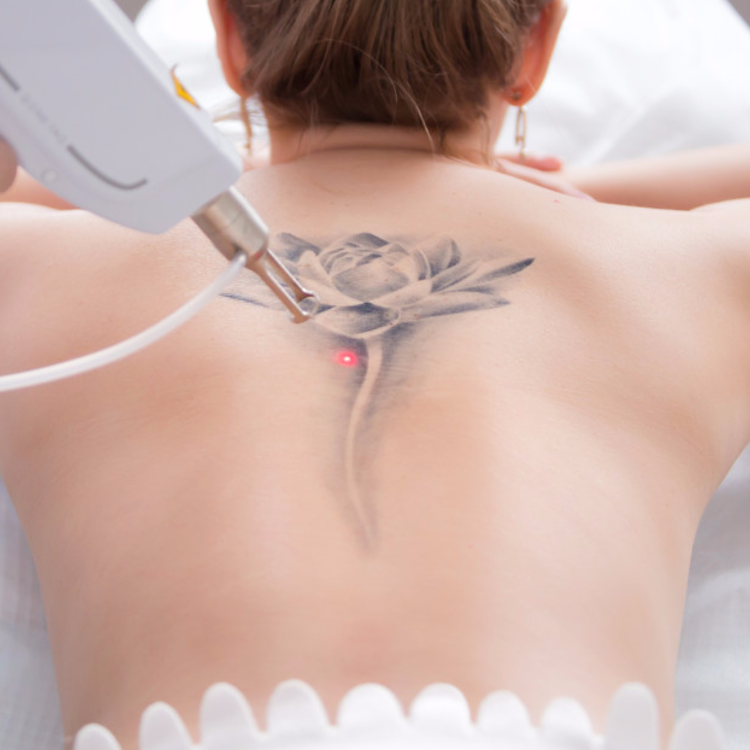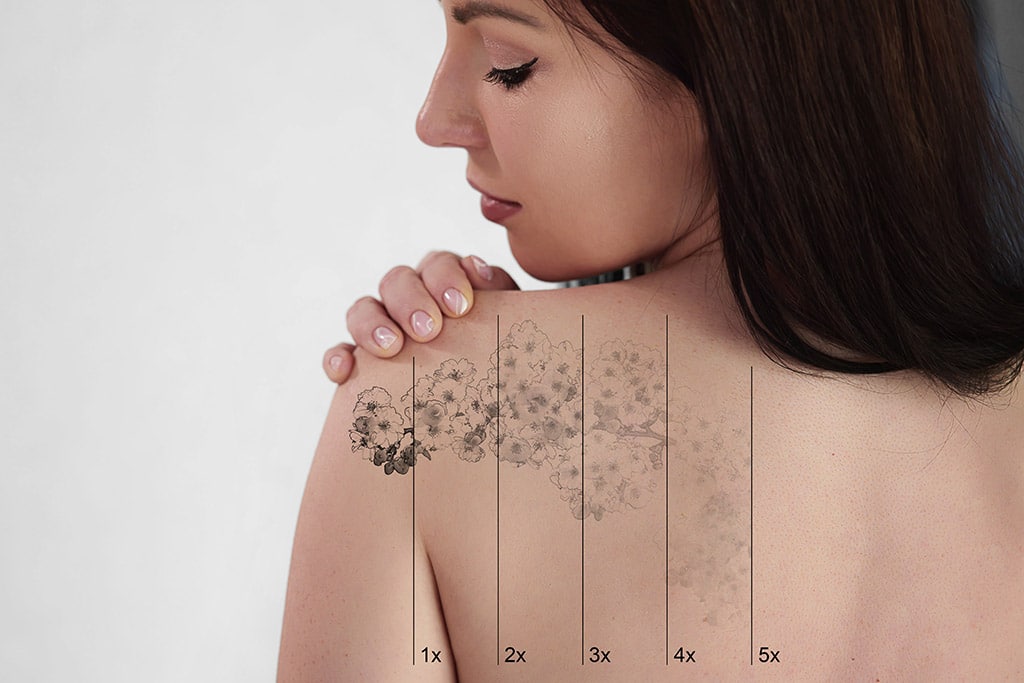
Laser Tattoo Removal
The Q-Switched laser is a gold standard for tattoo removal, utilizing 1064nm/532nm nanosecond laser technology to break up tattoo pigment with photoacoustic shockwaves.

Q-Switch Laser Unique Technology
The “Q” in Q switched laser treatment stands for “quality.”
The Q Switched laser has been determined as a gold standard for tattoo removal. A Q-switched laser is the only technology that is able to penetrate down to the dermis and shatter tattoo ink (via photo acoustic waves) without causing damage to the surrounding skin tissue. All other methods either aren’t capable of reaching and destroying the ink or cause too much damage to the skin, resulting in scarring. An added benefit of this is a quicker and less complicated healing time.
Frequently Asked Questions
Please reach us at [email protected] if you cannot find an answer to your question.
Good – Black, Blue, Dark Blue, Dark Green, Brown, Red, Purple, Orange.
Difficult – Tan, Yellow, Bright Green, Sky Blue.
In addition to tattoos Q-Switch can treat pigmented lesions including age spots, freckles, sunspots, and some birthmarks.
- It is imperative that you avoid significant sun exposure and tanning beds for at least 4 weeks prior to your treatment.
- Avoid applying self-tanner for 2 weeks prior to treatment.
- Avoid aspirin and Ibuprofen for one week prior to your treatment. Inform the provider if you are taking blood thinners or regularly take aspirin or ibuprofen.
- Avoid alcohol for 2 days prior to treatment.
- Inform the provider if have taken Accutane (oral acne medication) in the past year
Depending on the size of the treated area(s), after numbing, treatments can take several minutes up to an hour.
Avoid sun exposure/tanning beds for 2 weeks pre and post. Avoid pain medicine, such as Aleve, Aspirin for 3-7 days. Topical numbing cream may be used, and cold compress may be applied a prior to treatment.
The laser tattoo removal itself may not be uncomfortable but discomfort is a normal response during treatment and recovery. The targeted areas will feel tender and sensitive to touch due to swelling and blistering thereafter. Once these effects subside over the next few days, so does the pain.
Immediately after treatment, you will notice “frosting” on the area where the laser came in contact with the ink. This signals the first stage of healing, and it lasts for only a few minutes. This is accompanied by swelling around the treated area. Redness, tenderness and swelling usually subside a day or two after treatment. Blisters start forming within 24 hours after treatment and they may appear alarming, but these indicate that your body is healing as it should. Avoid picking on your blisters because they will drain on their own and dry into scabs.
The crust will eventually fall off within 10-14 days after treatment granted that the area doesn’t get irritated. One may even return to your usual activities shortly after treatment. The area will be bandaged to keep it dry for a few days following the treatment
The laser tattoo removal itself may not be uncomfortable but discomfort is a normal response during treatment and recovery. The targeted areas will feel tender and sensitive to touch due to swelling and blistering thereafter. Once these effects subside over the next few days, so does the pain.
Immediately after treatment, you will notice “frosting” on the area where the laser came in contact with the ink. This signals the first stage of healing, and it lasts for only a few minutes. This is accompanied by swelling around the treated area. Redness, tenderness and swelling usually subside a day or two after treatment. Blisters start forming within 24 hours after treatment and they may appear alarming, but these indicate that your body is healing as it should. Avoid picking on your blisters because they will drain on their own and dry into scabs.
The crust will eventually fall off within 10-14 days after treatment granted that the area doesn’t get irritated. One may even return to your usual activities shortly after treatment. The area will be bandaged to keep it dry for a few days following the treatment
Laser tattoo removal typically does involve some level of pain. That said, many say that it hurts less than they expected. It’s a common belief that tattoo removal is excruciating, yet most patients say that the sensation of removal is comparable to having a tattoo applied. Common descriptions include the sensation of a rubber band snapping against the skin or bacon grease – basically it’s uncomfortable but bearable.
- Keep out of the sun, out of pools/lakes/bath water until healed.
- Apply recovery balm and keep it covered for 5-6 days while healing.
- Apply ice 10 minutes post-treatment.
- Use sunscreen to protect the treated skin which is particularly sensitive to sunlight following treatment.
- Don’t apply makeup or any potentially irritating product on treated skin while it heals.
- Avoid shaving treated areas unless the skin is healed.
- Don’t soak in baths, hot tubs, or pools unless the skin has healed completely.
Recommended 6-10 treatments. The number of sessions needed to remove a tattoo depends on three factors: the tattoo’s age, color, and density.
- Age: Older tattoos can be removed with fewer treatments than newer tattoos. A black ink tattoo that is 10 years old may take one or two treatments fewer than a 1-year-old black tattoo. A 20-year-old tattoo may take two to three treatments fewer than a 1-year-old tattoo, but it’s easy to remove if your tattoo is brand new (1 month old).
- Color: Certain colors are more easily removed than others. Black and red tattoos are the easiest to remove. Orange, yellow, pink, and other shades are slightly more difficult to remove. The most difficult colors to remove are light green, light blue, and teal/turquoise.
- Location: Because tattoo removal depends on the body to flush away the shattered ink particles, areas of the body with less circulation often take more time to show results. The toes, fingers, ears, and nose are areas that may show slower results.
- Ink Density: Shading in a tattoo is easily removed. Some tattoos with letters use shading to fill in the outlines of the letters. Some tattoos with certain designs use shading for clouds or other visual effects. Shading will be removed in only a few sessions in most cases.
The sessions are spaced six to eight weeks apart, which allows your skin to process the treatment. Many people start to see their ink fade slightly after each subsequent session and greater improvement after three appointments. Given six to eight weeks between each session, you can expect the results to start showing a few months after the process starts.
There are a handful of symptoms you might see post-treatment such as blisters, swelling, raising of the tattoo, pinpoint bleeding, redness, temporary darkening, hypopigmentation, hyperpigmentation, and bruising. These are common and usually subside within a couple weeks. As always, consult your provider with concerns.


